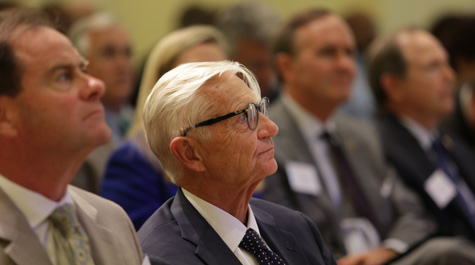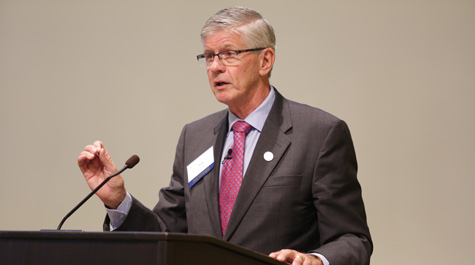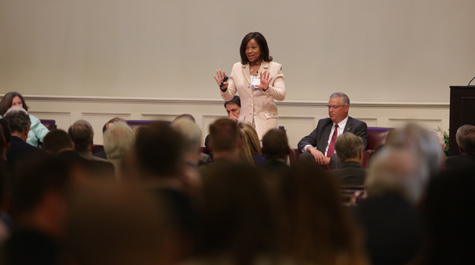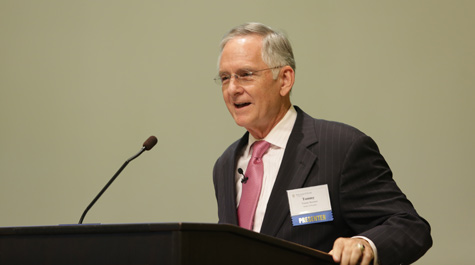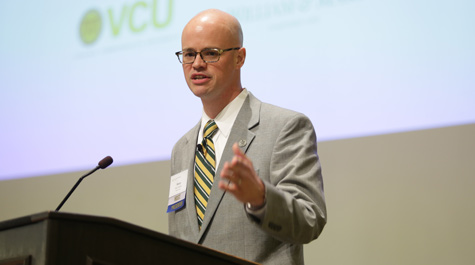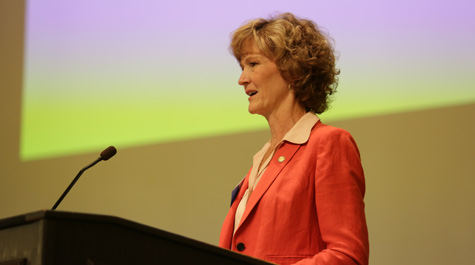Forum at W&M aligns higher ed, government, business
More than 300 state and local government, industry and higher education leaders turn out for regional economic development forum at W&M
As the region and state reinvigorate their economic development efforts, the Commonwealth’s colleges and universities will play a crucial role in helping to diversify the state’s industries.
That was one of the key messages included in a wide-ranging economic development forum hosted by William & Mary, Virginia Commonwealth University and Old Dominion University Tuesday at W&M’s Raymond A. Mason School of Business.
The business school welcomed more than 300 leaders in business, government and higher education to the four-hour forum that explored unifying the area spanning Richmond to Virginia Beach into a new, collaborative mega-region.
"[The mega-region] certainly has an elemental appeal for me,” said W&M President Taylor Reveley. “Because if it were to come to pass, guess what is squarely in the middle of the mega-region? How sweet that would be."
But it’s not just William & Mary that would rise in prominence as the mega-region became a global economic competitor. So would the area’s other colleges and universities, all of which are home to fundamental research that could help diversify the economy, lessening dependence on federal military spending.
Already, local models exist on how government, higher education and industry could work together. This year Virginia founded the Commonwealth Center for Recurrent Flooding Resiliency, a joint venture between William & Mary Law School’s Coastal Policy Center, W&M’s Virginia Institute of Marine Science and ODU that acknowledges years of work each institution has undertaken. Along the way, they’ve been funded by a host of federal, state and private grants totaling more than $10 million.
VCU’s School of Engineering is successfully working on bringing pharmaceutical manufacturing back to the United States through its pharmaceutical engineering program by partnering with outside federal and private funding sources, other universities and healthcare industry sponsors, said Barbara Boyan, VCU engineering school dean. The program involves all levels of the university, down to undergraduate interns, she said.
At Norfolk State, the university has developed similar partnerships to make the region a powerhouse for public and private cybersecurity, said Stacey Franklin Jones, interim vice president for academic affairs. The program not only focuses on providing a qualified workforce, but also innovation, entrepreneurship and commercial contracts.
The talent and potential at local institutions of higher education is such that Bob Crum, executive director of the Hampton Roads Planning District Commission, suggested that they could form the backbone of an “innovation corridor” along Interstate 64.
“It's clear that universities have a very critical role in where we're heading and what we're talking about today,” agreed Tom Frantz ’70, J.D. ’73, M.L.T. ’81, chair emeritus of Williams Mullen, executive committee member of the Hampton Roads Business Roundtable and member of W&M’s Board of Visitors.
Frantz explained the concept and importance of the mega-region, how it would work and what would be required to make it successful. Other presentations explained transportation improvements (planned and needed), and the value of Virginia’s ports to the region.
Support for collaboration across localities comes from the newly created Virginia Initiative for Growth and Opportunity in Each Region, or GO Virginia. The program is a business-led statewide initiative designed to grow and diversify the private sector, explained John Wynne, retired president and CEO of Landmark Communications.
Support for GO Virginia comes in part from two legislative actions the Virginia General Assembly and Gov. Terry McAuliffe approved this year, plus $5.5 million in seed money for year-one incentive grants and an additional $30 million budgeted for next year. The nonprofit’s goal is to incentivize collaboration for initiatives that create high-paying jobs, Wynne said, but each funded initiative must reach across its border to another locality.
"I remember when Virginia was the best place to do business in America. We have incrementally slipped,” said Virginia Senate Majority Leader Tommy Norment J.D. ’73, who also teaches in W&M’s law school. “The Commonwealth of Virginia and those who are in support of the GO Virginia legislation came to the conclusion that we must provide some incentives that are going to enhance collaboration and creativity for our common economic welfare … GO Virginia is a challenge, but it is an initiative that is innovative, that is creative, and it will be transformational.” Skip to main content
Skip to main content

